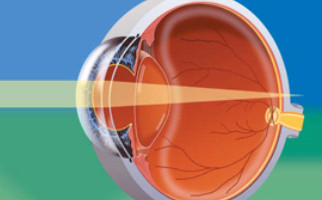Contents
Hypermetropia
Hypermetropia also known as farsightedness or hyperopia is a term used to define a refractive error in which light rays fall behind the light-sensitive layer of the retina instead of on it. In Hyperopia, a person can see objects at far clearly but not up close. In this condition our vision is fixed at far, that is why called farsightedness.
The mechanism of our eyes is similar to a camera. The light rays enter through the cornea and reach to retina passing through the lens and other inner layers of the eye. The retina transfers the signal to the brain via photo-receptors, forming an image. If there’s any defect in any layer of the eye it can cause multiple vision problems. One of them is Hypermetropia. A person with Hypermetropia finds it difficult to read, write, sew, or doing anything that needs a closer look.

Hypermetropia in children
Hyperopia is the most common vision disorder impacting children. It is a hereditary element that runs in the genes, therefore children are often born with it. Hypermetropia can lead to accommodative esotropia- which is a condition when one eye tries to make up for the refractive error in another eye causing eye-crossing. The majority of the children can correct hyperopia, mild hypermetropia goes unnoticed in children as their eyes are able to accommodate, thus increasing focus and curing blurry vision. Most of the infants are hypermetropic, but only about 4 out of 100 have it after age 1.

Causes of Hypermetropia
Hypermetropia is a common vision problem that occurs when your eyeball is smaller than usual, causing light rays to fall behind the retina. Hypermetropia is common in children. There are some reasons which could be the main factor of it-
- One of the causes of Hypermetropia could be the smaller size of the eyeball causing light rays to fall behind the retina. The retina is the innermost layer of the eyeball that sends the signals to the brain.
- Another reason for Hypermetropia could be genetics. A kid with a family history of this problem is most likely to suffer from it. But most of the time, the kid can accommodate and see well as he/grows.
- A flat cornea- curvature of your cornea, the outermost layer of the eye, will not let enough light rays enter the eye causing Hypermetropia. size of the cornea may also be smaller in size.
Symptoms of Hypermetropia
Hypermetropia is easily diagnosable as it becomes obvious, that you are unable to focus on nearby objects, even if it is asymptomatic, a simple eye test can diagnose it. Some other symptoms are –
Headache– it will cause a constant headache especially when you try to read or have a closer look at objects, leaving your eyes and you stressed. Reading and writing is a troublesome task for a hypermetropic person.
Sore eyes– if the hyperopia is in bad condition then you will have sore eyes leaving your eyes fatigued. You will have a difficult time finishing a puzzle, playing a game. If your work is computer related then you can feel eye itching/ squint. However, your far-viewing capacity stays unaffected.
Blurry vision– if you’re experiencing blurry vision especially when you try to focus on objects within 20-25 cm. you may have hyperopia.
Diagnosis of Hypermetropia
Diagnosis of Hypermetropia depends on the severeness of signs and symptoms observed. Also, your eyesight keeps changing, if you feel uneasy while seeing go set your eyes diagnosed.
Hypermetropia can be diagnosed with a simple eye exam. You will have to read a chart of letters, hang it across the room, after it the doctor will examine your eyes using a retinoscope- a device to observe the refractive error of a patient’s eye. After the test, you will know the condition of your eyes. An ophthalmologist suggests getting your eyes examined every year. If you have other health problems like high blood pressure or a family history of any eye diseases, then the chances are higher of being Hypermetropic.

Correction of Hypermetropia
Hypermetropia in children is cured naturally if it’s mild. In adults, an eyeglass is a convenient option. If it’s because of the flat cornea, it grows curvy as it grows; still, if the symptoms are seen and diagnosed at an early stage it’s easy to control Hypermetropia. There are some ways to correct this error-
1. Eyeglasses
convex lenses are used to correct hypermetropia. The main principle to correct hypermetropia is to bring the focus of light rays to the retina. It can be done with the help of convex lens plus (+) glasses. One of the main points to keep in mind while getting eyeglasses is to choose the light-weighted lenses to make them easier to work.
2. Contact lenses
with farsightedness, your prescription is a plus(+) number. Such as +2. The farther the number zero stronger the lenses you need. Prescription for eyeglasses and contact lenses slightly differs. So make sure you don’t misunderstand the two. Talk to your doctor, about what option will suits you well.
3. LASER Surgery
laser surgery involves fixing your cornea through laser treatment. There is no incision involved. This method is mostly used to treat myopia; however, it can also be used to cure hypermetropia. Laser surgery fixes refractive error via lengthening the size of the cornea to restore the focus on the retina. Laser treatment is of two types LASIK and LASEK. Farsightedness can be cured by LASIK which does not take more than 30 minutes, and you should be able to redo your daily activity in 2 days.
Children below 10 with low to moderate Hypermetropia do not require any glasses. Although ignoring symptomatic Hypermetropia may ruin the quality of life and affect your growth and development. If we talk about the surgery it can not be performed on anyone below 18, as our eyesight changes the most during this time.
Difference between Hypermetropia and Myopia- these two disorders are exactly opposite of each other. The difference between Hypermetropia and Myopia eyes is that hypermetropic eyes can see objects at a distance clearly(farsighted), but faces problems looking up close. Myopic eyes can see objects near better (nearsighted) but find farther away objects blur.
Can a person be both Myopic and Hypermetropic?
The question is quite twisted. As in Hypermetropia, the eyeball is smaller than usual and in myopia, the eyeball is bigger than usual. There is one more eye disorder called Astigmatism. In astigmatism, the cornea with abnormal curvature can create two focal points, which can lead light rays to fall in two different points, causing nearsightedness and farsightedness. In the case of astigmatism, it is possible to be nearsighted and farsighted but you can note be hypermetropic and myopic at the same time.
PRESBYOPIA and HYPERMETROPIA – you can be nearsighted and farsighted in case of presbyopia too which is an aging disorder that causes farsightedness or slow destruction of near vision. Presbyopia causes no problem in seeing distant objects but a higher degree of hypermetropia can affect distant vision causing both nearsightedness and farsightedness. Presbyopia is found in people above 40.



